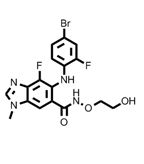MEK Inhibitor Active in NRAS-Mutated Melanoma
The MEK inhibitor MEK162 is the first agent to show some activity in patients with NRAS- and BRAF-mutated advanced melanoma, according to the conclusions of a phase II study, evaluating the drug’s safety and efficacy.
The MEK inhibitor MEK162 is the first agent to show some activity in patients with NRAS- and BRAF-mutated advanced melanoma, according to the conclusions of a phase II study, evaluating the drug’s safety and efficacy, published in Lancet Oncology. In addition, treatment with MEK162 resulted in the shrinkage of target brain metastases in two patients.

Chemical structure of MEK162
“Unlike for patients with BRAF mutations, no approved targeted therapies exist for patients with NRAS-mutated melanoma,” the researchers wrote in their conclusion. “This finding justifies a phase III randomized trial for MEK162 as first-line therapy in patients with stage IV NRAS-mutated melanoma and additional studies in subpopulations, such as patients with brain metastases.”
MEK162 is a selective, non–ATP-competitive allosteric inhibitor of MEK1 and MEK2. In this study, researchers enrolled 71 patients at university hospitals or private cancer centers in Europe and the United States, and assigned them to one of three treatment groups:
• Twice-daily 45-mg MEK162 for NRAS-mutated melanoma,
• Twice-daily 45-mg MEK162 for BRAF-mutated melanoma, or
• Twice-daily 60-mg MEK162 for BRAF-mutated melanoma.
The data reported in this study was for the patients assigned to 45-mg dosages. Patients were allowed to have had a prior BRAF-targeted therapy (17% of patients with BRAF mutations had).
By the data cutoff point, zero patients achieved a complete response. Six patients with NRAS-mutated melanoma, or 20% of patients, achieved a partial response, but only three of those were confirmed. Among patients with BRAF-mutated melanoma, eight patients, or 20%, had a partial response, with confirmed response in two patients.
Overall, the treatment was well tolerated, with 13% of the NRAS group and 27% of the BRAF group discontinuing treatment due to adverse events. Thirteen patients with NRAS-mutated melanoma reported grade 3/4 adverse events, the most common of which was an increase in blood creatinine phosphokinase, which occurred in 11 patients.
Two accompanying editorialists agreed with the researchers’ conclusion that MEK162 should be evaluated in a phase III trial, but questioned whether MEK inhibition with MEK162, “a drug with a relatively short median progression-free survival, a response duration of less than 2 months, and a modest chance of inducing long-term survival,” would be appropriate as front-line therapy in NRAS-mutated patients.
“Recent data for mutated NRAS as a predictive factor for response to high-dose interleukin 2 reinforces the notion of immunotherapies as front-line treatment for NRAS-mutated metastatic melanoma,” wrote Geoffrey T. Gibney, MD, and Jeffrey S. Weber, MD, of the department of cutaneous oncology and melanoma research, Moffitt Cancer Center, Tampa, Florida.
However, more research is needed to establish if MEK inhibition, immunotherapy, or standard chemotherapy will be most effective for this group of patients.